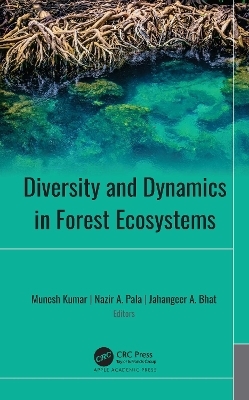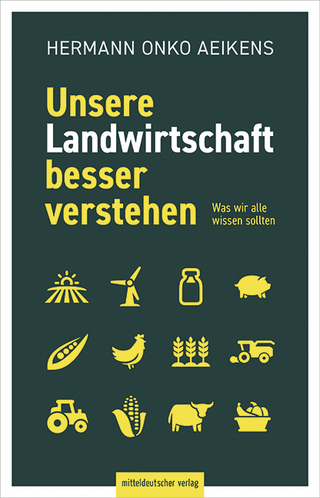
Diversity and Dynamics in Forest Ecosystems
Apple Academic Press Inc. (Verlag)
978-1-77188-979-7 (ISBN)
Providing a wealth of in-depth knowledge of forest ecosystems, this new volume explores a collection of important topics on forest community dynamics. It looks at the diversity of forest ecosystems and explores such aspects as forest products in enhancing local livelihoods and community participation, forage production, forest conservation and sustainable management, regeneration patterns, seed handling, and more.
Chapters in Diversity and Dynamics in Forest Ecosystems present new research on forest products, livelihood generation mechanisms of forest-dependent communities, utilization patterns of untapped resources from forests, and the structure of different ecosystems from the tropical to the temperate landscape. This book also features different drivers of community dynamics, such as the role of seed handling in forests, the influence of altitudinal variations, and protected and community-conserved forests on the forest diversity.
Chapters also consider the role of non-timber forest products and their significance in livelihood diversification for tribal communities and forage crop genetic resources, and forest resource extraction by forest fringe dwellers. Also explored are aspects of soil organic carbon in agroforestry systems and integrated approaches of sustainable agroforestry development in diverse forest ecosystems. This edition also examines the vegetation structure and regeneration aspects of timberline zone, including diversity of herbaceous flora along the altitudinal gradient.
The abundance of in-depth knowledge of the diversity and dynamics of forest ecosystems in this volume will be valuable in conservation and management of forests, which play an important role in the world environment. Forests are presently facing multiple disturbances, and this volume will help forestry professionals and others formulate further strategies to mitigate global climate change and other challenges.
Munesh Kumar, PhD, is Associate Professor in the Department of Forestry and Natural Resources at H.N.B. Garhwal University, Srinagar Garhwal, Uttarakhand, India. He also served at Mizoram University as Assistant Professor in the Department of Forestry. His area of research interest is forest ecology, agroforestry, and ethnobotany. He obtained his MSc and PhD degrees in forestry from H.N.B. Garhwal University. He has more than 15 years of teaching and research experience. He has published more than 120 research papers in international and national journals. Nazir A. Pala, PhD, is working as Assistant Professor cum Scientist in the Division of Silviculture and Agroforestry, Faculty of Forestry, at SKUAST- Kashmir, India. Dr. Pala has nine years of research and teaching experience at the under- and postgraduate levels. He has to date co-authored two books and published more than 100 research papers in both national and international journals. Dr. Pala is actively involved in several national-level research projects in the capacity of PI/Co-PI in addition to guiding students at the postgraduate level. He completed his schooling at J & K BOSE and earned his BSc, MSc, and PhD degrees in forestry at HNB Garhwal University, Srinagar Garhwal, Uttarakhand, India. Jahangeer A. Bhat, PhD, is Head of the Department of Forestry at the College of Agriculture, Fisheries and Forestry at Fiji National University, Republic of Fiji Islands. Dr. Bhat is a counselor, mentor, and coordinator for forestry academic programs. He has been instrumental for developing HE and TVET streams of forestry and allied programs and worked closely in the area of accreditation with the Fiji Higher Education Commission and forestry stakeholders. Before joining Fiji National University, he worked at H.N.B. Garhwal University and has 11 years of research and eight years of teaching experience, with a publication record of more than 50, which includes research articles, review papers, conference papers, and books with national and international repute. Dr. Bhat is reviewing research articles for a number of scientific journals and has handled research projects in his capacity as PI and Co PI. His major interests lie in emerging issues in forestry, including conservation of biodiversity, traditional knowledge of plants, and sustainable management of forest resources, with his main focus of research on vegetation ecology, ethnobotany, and evaluation of ecosystem services, forest plant biodiversity, climate change, and sociocultural issues in forestry.
1. Role of Non-Timber Forest Products from Madhuca latifolia in Enhancing Local Livelihoods and Household Dependency in Odisha 2. Grass/Legume Intercropping for Forage Production and Orchard Floor Management in Jammu and Kashmir 3. Tree Diversity and Soil Organic Carbon Status in Agroforestry Systems of Central Province of India 4. Climber Community Structure in Relation to Environmental and Tree Attributes in Lowland Tropical Forests of Eastern Himalaya, India 5. Vegetation Analysis and Regeneration Pattern of Dominant Tree Species in Timberline Zone of Nanda Devi Biosphere Reserve, Western Himalaya, Uttarakhand, India 6. Herbaceous Diversity Along the Altitudinal Gradient in a Protected Area 7. Forage Crop Genetic Resources of North-Western Himalayas: An Underutilized Treasure 8. Livelihood Security and Forest Resource Extraction by Forest Fringe Communities in Indian Himalayan Region 9. Integrated Approach of Sustainable Agroforestry Development in Cold Arid Region of Indian Himalaya 10. Traditional Practices in Forest Conservation: Experience From Indian Himalaya 11. Timber Volume Increments in the Woodlots of Guadalcanal Island 12. Diversity and Regeneration of Tree Species in Western Himalayas: A Case Study From Kedarnath Wildlife Sanctuary 13. Seed Handling of Tropical Forestry Species 14. Household Economic Dependence on Home Garden Forest Resources in Kashmir Himalaya, India
| Erscheinungsdatum | 30.12.2021 |
|---|---|
| Zusatzinfo | 60 Tables, black and white; 4 Line drawings, color; 77 Line drawings, black and white; 4 Halftones, color; 11 Halftones, black and white; 8 Illustrations, color; 88 Illustrations, black and white |
| Verlagsort | Oakville |
| Sprache | englisch |
| Maße | 156 x 234 mm |
| Gewicht | 910 g |
| Themenwelt | Schulbuch / Wörterbuch |
| Naturwissenschaften ► Biologie | |
| Technik ► Umwelttechnik / Biotechnologie | |
| Weitere Fachgebiete ► Land- / Forstwirtschaft / Fischerei | |
| ISBN-10 | 1-77188-979-9 / 1771889799 |
| ISBN-13 | 978-1-77188-979-7 / 9781771889797 |
| Zustand | Neuware |
| Informationen gemäß Produktsicherheitsverordnung (GPSR) | |
| Haben Sie eine Frage zum Produkt? |
aus dem Bereich


